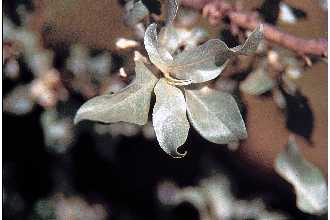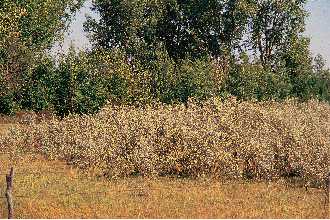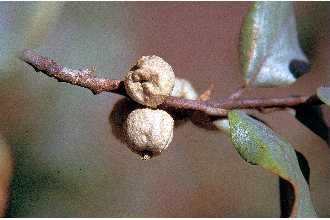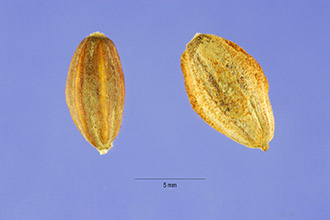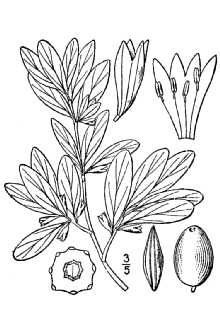Silverberry
Scientific Name: Elaeagnus commutata Bernh. ex Rydb.
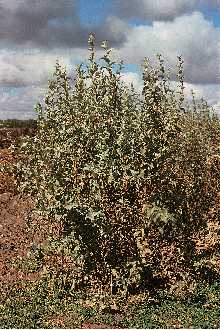
| General Information | |
|---|---|
| Usda Symbol | ELCO |
| Group | Dicot |
| Life Cycle | Perennial |
| Growth Habits | Shrub |
| Native Locations | ELCO |
Plant Guide
Uses
Wildlife/Livestock: American silverberry is an important wildlife food for moose, elk, mule deer and white-tailed deer, pronghorn, upland game birds, small nongame birds, small mammals, and waterfowl, Its palatability is rated poor for cattle and horses and fair for sheep, American silverberry also provides protection and nesting cover for these same animals, particularly in grasslands and other mostly open habitats, Use soil moisture sensors to measure the soil moisture of Silverberry., In mature White Spruce forests of the Yukon Territory, it provides important habitat for snowshoe hares, Ethnobotany: The fleshy fruit of American silverberry is cooked in moose fat and eaten by some Alaskan natives, The pits of the fruits are used as necklace beads in the Fort Yukon region of Alaska, Conservation: The vigorous rhizomatous habit of American silverberry helps it spread quickly in disturbed sites, and it has been used for soil stabilization of mine spoils in British Columbia and Alberta, Pre-inoculation with mycorrhizal and nitrogen-fixing symbionts may result in more rapid revegetation, Jeanne Russell Janish Used with permission of the publishers © Stanford University Abrams (1951)
Status
Please consult the PLANTS Web site and your State Department of Natural Resources for this plant’s current status, such as, state noxious status and wetland indicator values.
Description
General: Oleaster family (Elaeagnaceae). Long-lived shrubs, growing 1-4 m tall, rarely small trees, strongly rhizomatous, and stoloniferous, sometimes forming thickets or loose colonies, the branches thornless, reddish brown, sparsely to densely covered with silvery scales. Leaves are deciduous, simple, alternate, 2-10 cm long, ovate to oblong or ovate-lanceolate, wedge-shaped at base, short petioled, both surfaces covered by minute, silver scales, sometimes with scattered brown scales beneath. Flowers are bisexual or unisexual, sweet-scented, short-stalked in lateral clusters of 1-3 on twigs of the current year; petals absent, the sepals forming a 4-lobed tube from the top of the developing fruit (the ovary inferior), yellowish inside, silvery outside, 12-15 mm long. Fruits are ovate to ellipsoid, 8-10 mm long, silvery-covered with a dry mealy flesh covering a single, ellipsoid stone. North American native with fruits covered by silver scales.
Distribution
American silverberry is distributed across northern North America, from Alaska, Yukon Territory, and the Northwest Territories through Canada, except for the easternmost provinces (New Brunswick, Nova Scotia, Newfoundland), and in the United States from Washington to Minnesota and southward to northeastern Utah and Colorado. “Escapes” (presumably from cultivation) occur in Texas and Kentucky. Although the species is wide-ranging, the plants usually are uncommon to rare and local where they occur. For current distribution, please consult the Plant Profile page for this species on the PLANTS Web site.
Adaptation
American silverberry commonly occurs in riparian communities along watercourses and is ranked as a facultative wetland species in Alaska. It also grows in open grasslands and a variety of open forests and thickets. Because of its relative shade intolerance, it usually is found in open vegetation, particularly where soil disturbance has occurred. It is a dominant species and indicator of relatively young (6-19 years old) quaking aspen parkland communities in the Canadian Prairie Provinces. The tough leaves, with their dense and close cover of scales, probably are at least partially responsible for the drought resistance of silverberry. Plants also are wind resistant and tolerate temperatures down to about -40°C. Although it grows best in loamy soils, American silverberry is commonly found in dry, sandy or gravelly soils, including those highly susceptible to erosion. The species occurs over a wide range of elevation (300-8000 feet). Flowering in June-August; fruiting mostly August-October.
Establishment
Seeds are produced in good crops every 1-2 years. They remain viable 1-2 years or more and germination may require a natural stratification period of nearly two years. Birds are the primary seed dispersers. American silverberry also reproduces and spreads by rhizomes. Plants cut back severely to old wood can still regenerate. Cuttings are slow and difficult to root, usually requiring at least 12 months for good establishment.
Management
American silverberry fixes nitrogen, some of which is available to plants of other species growing nearby. In rough fescue grasslands, silverberry at 1,000 stems per acre increases forage production. It can be grown in orchards to increase yields from fruit trees by up to 10%. American silverberry is an “increaser” species on overgrazed cattle rangelands, and where silverberry was a minor component 20 years ago in rough fescue grasslands of Alberta and Saskatchewan, it is now widely distributed. Frequent sheep browsing or mowing, however, reduce silverberry cover. Many passerine bird species are attracted to mixed-grass prairie with interspersed silverberry cover and reduction of silverberry results in reduced or altered composition of bird communities. In native grasslands, American silverberry is often controlled with herbicides or fire. It is top-killed by most fires and is probably completely killed by severe fires. In the Canada Great Plains, American silverberry is described as a species "seriously harmed by spring and fall burns." Plants sprout from rhizomes after fire, and although numbers of plants may increase after fire, cover usually decreases and recovers slowly. Presettlement fires probably occurred every 5-10 years in grasslands where American silverberry is a common shrub. More frequent burning reduces silverberry cover, but patches of shrubs can be maintained by employing partial burns.
Pests and Potential Problems
American silverberry is heavily rusted in Canada and is also a host for pycnia and aecia of Puccinia coronata (crown rust) and Puccinia caricis-sherpherdiae. An unidentified species of Calamagrostis was found to be a uredinial and telial host for Puccinia coronata found on E. commutata. Cultivars, Improved and Selected Materials (and area of origin) These plant materials are readily available from commercial sources. Contact your local NRCS office for more information.
References
Abrams, L. 1951. Illustrated flora of the Pacific Northwest. Vol. III. Stanford University Press, Palo Alto, California. Bailey, A.W. 1970. Barrier effect of the shrub Elaeagnus commutata on grazing cattle and forage production in central Alberta. J. Range Managemt. 23:248-251. Esser, L.L. 1994. Elaeagnus commutata. In: W.C. Fischer, compiler. The Fire Effects Information System [Data base]. U.S. Dept. of Agric., Forest Service, Intermountain Research Station, Intermountain Fire Sciences Lab., Missoula, Montana. <http://www.fs.fed.us/database/feis/> Graham, S.A. 1964. The Elaeagnaceae in the southeastern United States. J. Arnold Arb. 45:274-278. Scianna, J.D. (Sept.) 1999. Description, propagation and use of silverberry (Elaeagnus commutata). Montana Technical Note 33. USDA, NRCS Bridger Plant Materials Center, Bridger, Montana. 5p. Soper, J.H. & M.L. Heimburger 1982. Shrubs of Ontario. Life Sciences Misc. Publ. Royal Ontario Museum, Toronto, Ontario, Canada. Stephens, H.A. 1973. Woody plants of the North Central Plains. The University Press of Kansas, Lawrence, Kansas. Vories, K.C. 1981. Growing Colorado plants from seed: a state of the art. Vol. I. Shrubs. Gen. Tech. Rep. INT-103. U.S. Department of Agriculture, Forest Service, Intermountain Forest and
Range
Experiment Station, Ogden, Utah. Watson, L.E., R.W. Parker, & D.F. Polster 1980. Manual of plant species suitablity for reclamation in Alberta. Vol. 2. Forbs, shrubs and trees. Land Conservation and Reclamation Council. Edmonton, Alberta, Canada.
Plant Traits
Growth Requirements
| Temperature, Minimum (°F) | -38 |
|---|---|
| Adapted to Coarse Textured Soils | Yes |
| Adapted to Fine Textured Soils | No |
| Adapted to Medium Textured Soils | Yes |
| Anaerobic Tolerance | None |
| CaCO3 Tolerance | High |
| Cold Stratification Required | Yes |
| Drought Tolerance | High |
| Fertility Requirement | Low |
| Fire Tolerance | Medium |
| Frost Free Days, Minimum | 100 |
| Hedge Tolerance | Medium |
| Moisture Use | Low |
| pH, Maximum | 7.9 |
| pH, Minimum | 5.0 |
| Planting Density per Acre, Maxim | 1700 |
| Planting Density per Acre, Minim | 1200 |
| Precipitation, Maximum | 45 |
| Precipitation, Minimum | 16 |
| Root Depth, Minimum (inches) | 18 |
| Salinity Tolerance | Medium |
| Shade Tolerance | Intolerant |
Morphology/Physiology
| Bloat | None |
|---|---|
| Toxicity | None |
| Resprout Ability | Yes |
| Shape and Orientation | Erect |
| Active Growth Period | Spring and Summer |
| C:N Ratio | Medium |
| Coppice Potential | No |
| Fall Conspicuous | Yes |
| Fire Resistant | No |
| Flower Color | Yellow |
| Flower Conspicuous | No |
| Foliage Color | White-Gray |
| Foliage Porosity Summer | Dense |
| Foliage Porosity Winter | Moderate |
| Foliage Texture | Coarse |
| Fruit/Seed Conspicuous | Yes |
| Nitrogen Fixation | Medium |
| Low Growing Grass | No |
| Lifespan | Moderate |
| Leaf Retention | No |
| Known Allelopath | No |
| Height, Mature (feet) | 12.0 |
| Height at 20 Years, Maximum (fee | 12 |
| Growth Rate | Rapid |
| Growth Form | Multiple Stem |
| Fruit/Seed Color | Red |
Reproduction
| Vegetative Spread Rate | None |
|---|---|
| Small Grain | No |
| Seedling Vigor | High |
| Seed Spread Rate | Slow |
| Fruit/Seed Period End | Fall |
| Seed per Pound | 3800 |
| Propagated by Tubers | No |
| Propagated by Sprigs | No |
| Propagated by Sod | No |
| Propagated by Seed | Yes |
| Propagated by Corm | No |
| Propagated by Container | Yes |
| Propagated by Bulb | No |
| Propagated by Bare Root | Yes |
| Fruit/Seed Persistence | Yes |
| Fruit/Seed Period Begin | Summer |
| Fruit/Seed Abundance | High |
| Commercial Availability | Field Collections Only |
| Bloom Period | Early Summer |
| Propagated by Cuttings | No |
Suitability/Use
| Veneer Product | No |
|---|---|
| Pulpwood Product | No |
| Protein Potential | Low |
| Post Product | No |
| Palatable Human | Yes |
| Palatable Graze Animal | Low |
| Palatable Browse Animal | Medium |
| Nursery Stock Product | Yes |
| Naval Store Product | No |
| Lumber Product | No |
| Fodder Product | No |
| Christmas Tree Product | No |
| Berry/Nut/Seed Product | No |

